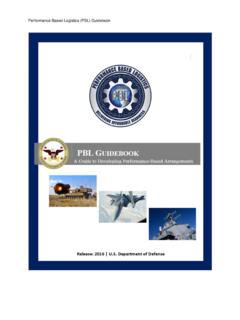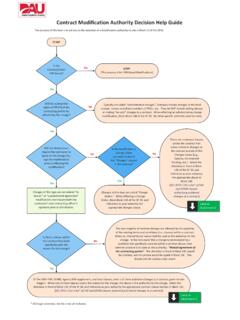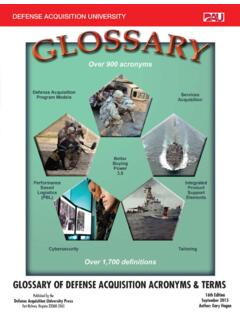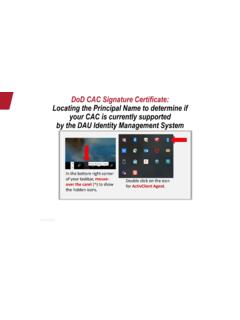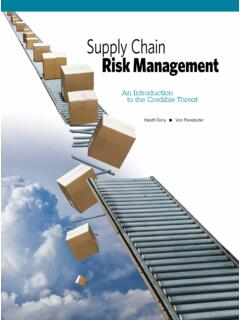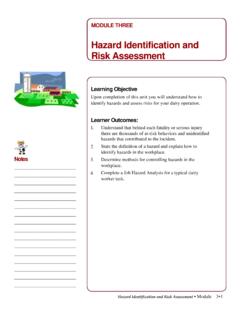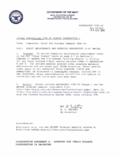Transcription of Condition Based Maintenance Plus DoD Guidebook - DAU
1 Condition Based Maintenance Plus DoD Guidebook May 2008 2 3 Contents Condition Based Maintenance Plus DoD Guidebook .. 1 Contents .. 3 Section 1. Introduction to CBM+ .. 6 Definition .. 6 Why Change? .. 6 CBM+ 7 Achieving More Effective Maintenance .. 9 Goals of CBM+ .. 9 Benefits of CBM+ .. 11 CBM+ End State Vision .. 11 How to Use This Guidebook .. 12 Section 2. Background of CBM+ .. 14 Traditional Maintenance .. 14 How Is Maintenance Accomplished Today? .. 14 Reactive and Proactive Maintenance Approaches .. 15 Examples of Component CBM+ Initiatives .. 18 Updates .. 19 Section 3. Essential Elements of CBM+ .. 19 Business/Management .. 20 Technical .. 33 CBM+ Essential Elements Summary .. 47 Section 4. Getting Started CBM+ Implementation .. 48 Creating the CBM+ Environment .. 48 CBM+ and the Acquisition Life Cycle .. 49 Section 5. Managing a CBM+ Initiative or Project .. 63 A CBM+ Program Review Checklist .. 63 A CBM+ Management Approach.
2 64 CBM+ Relationships with Other DoD Efforts .. 65 Overcoming Barriers to CBM+ Implementation .. 68 Twenty Questions a Manager Should Consider .. 68 Section 6. Measuring Success .. 69 4 Implementation Metrics How to Measure a Successful Implementation .. 70 Operating Metrics How to Measure a Maintenance Program Operating in a CBM+ Environment .. 72 Attachment E. CBM+ Technologies, Enabling Tools, and Best Practices .. 75 Attachment F. Resources and References .. 80 Attachment G. CBM+ Implementation Plan Template .. 82 Attachment H. Overcoming the Resistance to Change .. 85 Attachment I. Abbreviations .. 87 Figures Figure 1-1. O&S Costs .. 6 Figure 1-2. Logistics Efforts That Support TLCSM .. 7 Figure 1-3. CBM+ Overview .. 8 Figure 2-1. Range of Maintenance Approaches .. 15 Figure 2-2. Evolution of Maintenance Strategy .. 16 Figure 2-3. Maintenance Strategy Transition.. 17 Figure 3-1. CBM+ Element Primary and Sub-Groups .. 20 Figure 3-2. Alternatives within a Business Case Analysis.
3 28 Figure 3-3. Classic P-to-F Curve .. 30 Figure 3-4. CBM+ Infrastructure Areas .. 33 Figure 3-5. CBM+ Notional Data Environment .. 36 Figure 3-6. Generalized Inputs and Outputs from a Prognostic Model .. 37 Figure 3-7. DoDAF Architecture Product Relationships .. 39 Figure 3-8. CBM+ Generic Architecture Overview .. 40 Figure 4-1. CBM+ and the Total System Life Cycle .. 49 Figure 5-1. Plan, Do, Check, and Act Model .. 64 Figure 5-2. TLCSM Relationship .. 66 Figure A-1. Structured Approach to Technology Implementation .. 77 5 Tables Table 1-1. CBM+ Objectives and Metrics .. 10 Table 2-1. CBM+ Background Checklist .. 14 Table 3-1. Essential Elements Checklist .. 19 Table 3-2. CBM+ Capabilities Relative to RCM Process Steps .. 32 Table 3-3. Examples of Standards Available to CBM+ Implementers .. 45 Table 4-1. Getting Started Checklist .. 48 Table 5-1. CBM+ Program Manager s Checklist .. 63 Table 6-1. Measuring Success Checklist .. 69 Table 6-2. A CBM+ Capability Scorecard.
4 70 Table 6-3. Internal Progress Evaluation 71 Table A-1. Technologies, Tools, and Practices Checklist .. 75 Table D-1. Actions to Overcome Resistance .. 87 6 Section 1. Introduction to CBM+ Definition Condition Based Maintenance Plus (CBM+) is the application and integration of appropriate processes, technologies, and knowledge- Based capabilities to improve the reliability and Maintenance effectiveness of DoD systems and components. At its core, CBM+ is Maintenance performed Based on evidence of need provided by Reliability Centered Maintenance (RCM) analysis and other enabling processes and technologies. CBM+ uses a systems engineering approach to collect data, enable analysis, and support the decision-making processes for system acquisition, sustainment, and Why Change? A number of changes in the world situation, business management, and emerging technologies have resulted in major changes to National Defense Strategy. In response to these changes, the Secretary of Defense has said, We will continually adapt how we approach and confront challenges, conduct business and work with More specifically, the Secretary has stated: Forces employing transformational warfighting concepts require transformed supporting processes that produce the timely results demanded by 21st century security challenges.
5 Senior leadership must take the lead in fostering innovation and adaptation of information age technologies and The life-cycle impact is clear when operations and support (O&S) costs are compared to total ownership costs, as shown in Figure 0-1. Figure 0-1. O&S Costs DoD has identified warfighter expectations and made an effort to conduct support operations in a more effective as well as fiscally responsible manner. Under the umbrella of Total Life Cycle System Management (TLCSM), the sustainment of a weapon system receives increased attention from Service leadership and program managers. TLCSM establishes clear responsibilities and accountability for meeting warfighter expectations. It sets goals, tracks progress and status, and balances resources to accomplish desired material readiness. CBM+, in concert with the other TLCSM tools (Continuous Process Improvement [CPI], cause-and-effect predictive modeling and simulation [M&S], and desired outcomes 1 DoD Instruction , Condition Based Maintenance Plus for Materiel Maintenance , December 2, 2007.)
6 2 Secretary of Defense, National Defense Strategy 2005, March 2005. 3 Secretary of Defense, Transformational Planning Guidance 2003, April 2003. 7 achieved through Performance Based Logistics [PBL]), will enhance materiel readiness. Figure 0-2 displays the relationship of these tools to TLCSM. Figure 0-2. Logistics Efforts That Support TLCSM CBM+ supports the larger DoD improvement efforts of the Under Secretary of Defense for Acquisition, Technology, and Logistics (USD[AT&L]), with the goal of delivering cost-effective joint logistics performance by maximizing weapon system and equipment availability through a more effective logistics process. The strategy fully supports these broad, long-term goals articulated in the AT&L Strategic Goals Implementation Plan:4 A high-performing, agile, and ethical workforce Strategic and tactical acquisition excellence Focused technology to meet warfighting needs Cost-effective joint logistics support for the warfighter Reliable and cost-effective industrial capabilities sufficient to meet strategic capabilities Improved governance and decision processes Capable, efficient, and cost-effective installations.
7 To satisfy these goals and achieve its future materiel Maintenance requirements, DoD must enhance materiel availability at the best possible cost by establishing integrated, predictive Maintenance approaches that minimize unscheduled repairs; eliminate unnecessary Maintenance activity; and employ the most cost-effective Maintenance health management approaches. To meet these challenges, DoD management is paying specific attention to CBM+ to ensure its timely implementation in new acquisition programs and across the sustainment life cycle for DoD weapon systems and equipment. CBM+ History CBM+ was originally developed as a DoD initiative to provide a focus for a broad variety of Maintenance improvements that would benefit both the maintainer and the warfighter. It was established to expand upon Condition - Based Maintenance (CBM) and encompass other technologies, processes, and procedures that enable improved Maintenance and logistics CBM is an established approach to identifying and scheduling Maintenance tasks.
8 It employs continuous or periodic assessment of weapon system Condition using sensors or external tests and measurements through first-hand observation or portable equipment. The goal of CBM is to perform Maintenance only when there is evidence of need. Synergy from integrating the enabling CBM+ capabilities builds upon the foundation of CBM. CBM+ continues to evolve from this original concept into the Maintenance improvement strategy that is discussed in this Guidebook . 4 USD(AT&L), Strategic Goals Implementation Plan for FY2007, November 2006. 5 Deputy Under Secretary of Defense (Logistics and Materiel Readiness), Memorandum for the Secretaries of the Military Departments, Condition Based Maintenance Plus, November 25, 2002. 8 CBM+ includes a conscious effort to shift equipment Maintenance from an unscheduled, reactive approach at the time of failure to a more proactive and predictive approach that is driven by Condition sensing and integrated, analysis- Based decisions.
9 CBM+ focuses on inserting technologies that improve Maintenance capabilities and processes into both new and legacy weapon systems and integrates the support elements to enable enhanced Maintenance -centric logistics system responses. With more accurate predictions of impending failures ( Based on real-time Condition data), coupled with more timely and effective repairs, moving toward CBM+ will result in dramatic savings in time and money and improved weapon system availability and performance. CBM+ uses modern Maintenance tools, technologies, and processes to detect the early indications of a fault or impending failure to allow time for Maintenance and supply channels to react and minimize the impact on system operational readiness and life-cycle costs. CBM+ provides a means of optimizing the approach to Maintenance , and is a vehicle to reduce scheduled Maintenance requirements. The flexibility and optimization of Maintenance tasks with CBM+ also reduces requirements for Maintenance manpower, facilities, equipment, and other Maintenance resources.
10 CBM+ is not a single process in itself. It is a comprehensive strategy to select, integrate, and focus a number of process improvement capabilities, thereby enabling Maintenance managers and their customers to attain the desired levels of system and equipment readiness in the most cost-effective manner across the total life cycle of the weapon system. CBM+ includes a variety of interrelated and independent capabilities and initiatives some procedural and some technical that can enhance basic Maintenance tasks. At its core, CBM+ is Maintenance performed upon evidence of need provided by RCM analysis and other enabling processes and technologies. Advanced engineering, Maintenance , and information system technologies, as well as contemporary business processes that underpin CBM+, fit in categories as shown in Figure 0-3. Figure 0-3. CBM+ Overview CBM+ includes, but is not limited to, the following examples: Hardware system health monitoring and management using embedded sensors; integrated data bus 9 Software decision support and analysis capabilities both on and off equipment; appropriate use of diagnostics and prognostics; automated Maintenance information generation and retrieval Design open system architecture; integration of Maintenance and logistics information systems; interface with operational systems; designing systems that require minimum Maintenance ; enabling Maintenance decisions Based on equipment Condition Processes RCM analysis; a balance of corrective, preventive, and predictive Maintenance processes; trend- Based reliability and process improvements; integrated information systems providing logistics system response; CPI; Serialized Item Management Communications databases.

